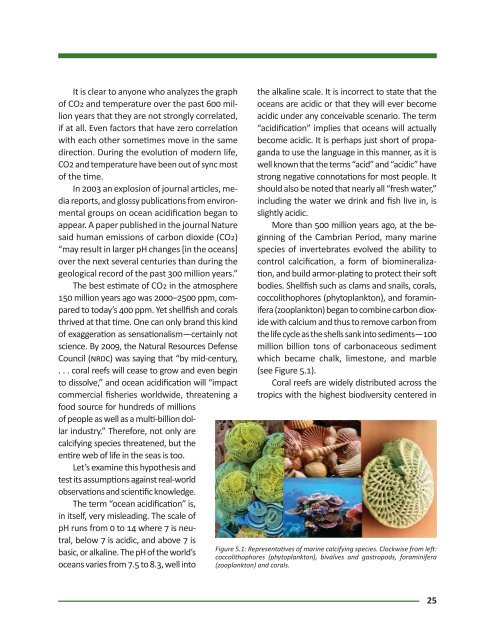The Climate Surprise
The-Climate-Surprise_CO2C-New-Criterion-1
The-Climate-Surprise_CO2C-New-Criterion-1
Create successful ePaper yourself
Turn your PDF publications into a flip-book with our unique Google optimized e-Paper software.
It is clear to anyone who analyzes the graph<br />
of CO and temperature over the past million<br />
years that they are not strongly correlated,<br />
if at all. Even factors that have zero correlaon<br />
with each other somemes move in the same<br />
direcon. During the evoluon of modern life,<br />
CO and temperature have been out of sync most<br />
of the me.<br />
In an explosion of journal arcles, media<br />
reports, and glossy publicaons from environmental<br />
groups on ocean acidificaon began to<br />
appear. A paper published in the journal Nature<br />
said human emissions of carbon dioxide (CO)<br />
“may result in larger pH changes [in the oceans]<br />
over the next several centuries than during the<br />
geological record of the past million years.”<br />
<strong>The</strong> best esmate of CO in the atmosphere<br />
million years ago was – ppm, compared<br />
to today’s ppm. Yet shellfish and corals<br />
thrived at that me. One can only brand this kind<br />
of exaggeraon as sensaonalism—certainly not<br />
science. By , the Natural Resources Defense<br />
Council () was saying that “by mid-century,<br />
. . . coral reefs will cease to grow and even begin<br />
to dissolve,” and ocean acidificaon will “impact<br />
commercial fisheries worldwide, threatening a<br />
food source for hundreds of millions<br />
of people as well as a mul-billion dollar<br />
industry.” <strong>The</strong>refore, not only are<br />
calcifying species threatened, but the<br />
enre web of life in the seas is too.<br />
Let’s examine this hypothesis and<br />
test its assumpons against real-world<br />
observaons and scienfic knowledge.<br />
<strong>The</strong> term “ocean acidificaon” is,<br />
in itself, very misleading. <strong>The</strong> scale of<br />
pH runs from to where is neutral,<br />
below is acidic, and above is<br />
basic, or alkaline. <strong>The</strong> pH of the world’s<br />
oceans varies from . to ., well into<br />
the alkaline scale. It is incorrect to state that the<br />
oceans are acidic or that they will ever become<br />
acidic under any conceivable scenario. <strong>The</strong> term<br />
“acidificaon” implies that oceans will actually<br />
become acidic. It is perhaps just short of propaganda<br />
to use the language in this manner, as it is<br />
well known that the terms “acid” and “acidic” have<br />
strong negave connotaons for most people. It<br />
should also be noted that nearly all “fresh water,”<br />
including the water we drink and fish live in, is<br />
slightly acidic.<br />
More than million years ago, at the beginning<br />
of the Cambrian Period, many marine<br />
species of invertebrates evolved the ability to<br />
control calcificaon, a form of biomineraliza-<br />
on, and build armor-plang to protect their so<br />
bodies. Shellfish such as clams and snails, corals,<br />
coccolithophores (phytoplankton), and foraminifera<br />
(zooplankton) began to combine carbon dioxide<br />
with calcium and thus to remove carbon from<br />
the life cycle as the shells sank into sediments—<br />
million billion tons of carbonaceous sediment<br />
which became chalk, limestone, and marble<br />
(see Figure .).<br />
Coral reefs are widely distributed across the<br />
tropics with the highest biodiversity centered in<br />
Figure 5.1: Representaves of marine calcifying species. Clockwise from le:<br />
coccolithophores (phytoplankton), bivalves and gastropods, foraminifera<br />
(zooplankton) and corals.<br />
25


